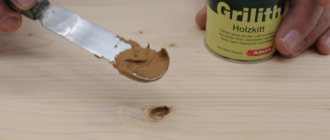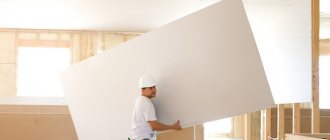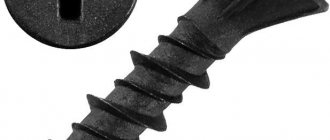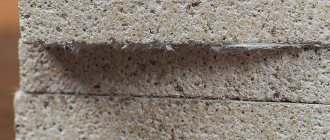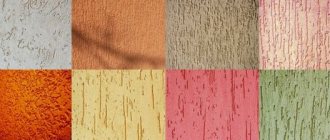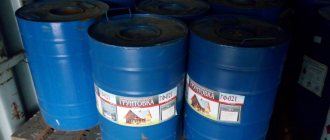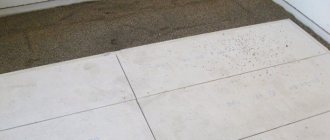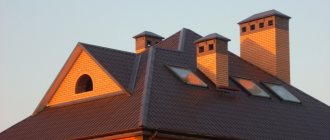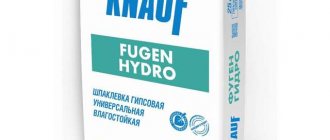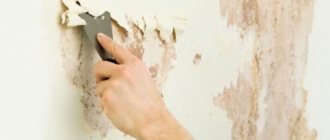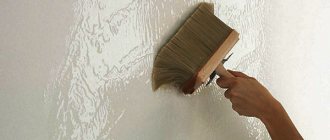When renovations begin in a house or apartment, you simply cannot do without the use of certain materials. For painting walls, gluing wallpaper and preparing the base for subsequent decorative finishes, in general, there is putty. It is suitable for both internal processes and façade designs. Today I will tell you what oil-adhesive putty is, where it can be used, its technical characteristics according to GOST, as well as what are the disadvantages and advantages of putty.
Oil-adhesive putty
Main components
The main binder of the material is drying oil . The fillers are:
- Glue.
- Chalk or lime.
- Plasticizers for better adhesion and application.
- Dryers for quick drying of oils.
- Water.
Manufacturers strive to improve the characteristics of the substance, so everyone adds additives or additives at their own discretion. It also cannot do without thickeners and pigments. For these reasons, the color of oil putty may vary depending on the manufacturer.
Plasticizers and modifiers in the composition slightly change the technical characteristics depending on the quantity. Therefore, they are added to impart certain functional values to materials. Thanks to this, you can find compounds on the market that are considered fireproof or ultra-strong. There is putty that is specially white so that it does not need to be painted.
How long does it take for the finished mixture to dry?
The drying time of the putty depends on:
- type of putty mixture;
- thickness of the applied layer;
- air temperature/humidity;
- the base on which the composition is applied.
The average drying rates are:
- starting gypsum mixture with a layer thickness of up to 30 mm - one week;
- finishing composition of gypsum - 4-6 hours;
- starting cement mortar - 5 hours;
- finishing layer up to 3 mm - 1 hour.
Regarding polymer putty solutions:
- epoxy - 8 hours;
- latex - from 12 hours;
- acrylic starting layer up to 1 mm thick - 3 hours, finishing layer 3 mm - 24 hours.
The leveling mixture can harden quite quickly, so to save money it is better to knead it in small quantities.
During repair work, the process of filling walls cannot be ignored, since only after completing this stage can the desired result be achieved. Knowing the rules of kneading and the technology for applying the leveling agent, the implementation will not require much effort and will be within the control of even a novice master.
Specifications
The material is intended for interior finishing work - leveling before painting. Work can be carried out on concrete or wooden surfaces. The putty can be painted with enamel, water-dispersion and oil paints.
Oil-adhesive putty has the following technical characteristics:
- Consistency – paste-like mass with a homogeneous consistency. Foreign impurities are excluded.
- Consumption. For single-layer application with a thickness of no more than 1 mm - 0.8-1.5 kg per square meter. m.
- Dry residue. No higher than 70–80%.
- Drying time: Before applying the next layer – no more than 4 hours;
- Drying of the topcoat takes no more than a day.
Note! Each manufacturer can produce material according to technical regulations for a specific production. This leads to variability in the characteristics of products from different manufacturers.
Results
DIY wall decoration
Obviously, the oil-adhesive mixture has enough advantages for working inside the house, but using it for external facade work is impossible. Unlike technologies for applying other types of putties, oil-based adhesive is very simple and easy to apply, and its hardening time allows you to avoid large gaps between certain stages of leveling work.
Advantages and disadvantages of the material
Based on their characteristics, it is possible to highlight the advantages and disadvantages of the material when used on construction sites. They should be used to determine where the use of adhesive putty will be relevant and will not cause harm.
Advantages of the composition:
- Easy to use. Most putties must be prepared before use. But the oil-adhesive leveling composition is sold ready-made, and it does not need to be mixed before applying to the surface.
- Relatively low cost. Pricing will please the customer. Moderate pricing for the composition allows it to be used over a large area of finishing work.
- High adhesion. This applies to all types of surfaces.
- Low consumption. It is about 1 kilogram per square meter.
- High plasticity. This makes the application process easier.
- Dries quickly. This allows you to speed up the pace of work, since technological breaks between finishing stages are reduced.
- Durability. The oil finish has a long service life.
- Environmentally friendly. The composition contains no harmful impurities.
The finishing material has enough advantages, but there are also disadvantages. They limit the use of oil putty when carrying out exterior finishing work, as well as for interior finishing of rooms with high levels of humidity. The material doesn’t like the mechanical impact either.
Flaws:
- Low resistance to mechanical stress.
- Does not tolerate moisture well.
- Short shelf life.
- Poor compatibility with other materials.
The material is made on the basis of drying oil, and this dictates its use only in cases where the finishing will be done with oil-based materials. Oil-based leveling base does not interact well with other materials. This is its main disadvantage.
With environmental friendliness and hygiene, not everything is simple either. Some manufacturers save money and use technical drying oil to add to putty . This drying oil has some toxicity, albeit minor. You can get rid of it by normal ventilation of the room. But this is not always possible due to weather conditions. There have been no cases of poisoning from this type of finishing coating.
Remember! In winter or in rainy weather, you should not ventilate the room with drying oil-adhesive putty, as it is afraid of moisture.
The shelf life also plays a role in the application of the coating. Over a long period of storage, the material will lose its main advantage - plasticity during application. When stored in an environment with a negative temperature, the material is unsuitable for work - this is also an important feature of adhesive putty.
Review of manufacturers
The putties on the market are manufactured by domestic enterprises. They are distinguished by their low price (less than 100 rubles/kg) and adhere well to different types of surfaces. Among the common brands :
- Olecolor from the Voronezh company ABC Farben is a composition containing drying oil and PVA glue. Suitable for various types of surfaces, including wood. When dry, it forms a matte surface that is resistant to dry abrasion.
- “Rainbow Magic” - adheres to walls made of different materials, provided that they have not been treated with other putties. It does not contain solvents and is easy to sand. Plastic, fills cracks.
- “Lakra” - used for leveling plastered walls. Also suitable for asbestos cement and aerated concrete blocks. It can be stored for only six months and has a high consumption - 3 kg/m² for a layer of 1 mm.
- “Expert” from LKP “Descartes” - used for working with wood and some materials based on it. Also suitable for sealing cracks in brick or concrete walls.
Cost of oil-adhesive putty
Dilution and application of putty
Note ! Oil-adhesive putty is demanding on the indoor microclimate during application. According to the instructions, work with the material should be carried out at a temperature not lower than +10 – +15 degrees. The optimal application temperature is about +20 degrees. Humidity should be at 70%.
Preparing the surface for work
The surface for work should be prepared. This must be done before diluting the putty, otherwise there is a risk of the material drying out in the container. Surface preparation involves cleaning walls and ceilings from grease, dirt and dust . This will improve the adhesion of the material to the surface. The old coating also needs to be removed, as well as peeling parts of the wall, such as concrete chips, for example.
After cleaning the surface, a primer will be required. As additional protective measures, you can treat the surface with anti-fungal materials. The surfaces are allowed to dry after priming and only then they begin to prepare the putty for work.
Required Tools
To carry out the work you will need a tool. It's simple. In his absence, there will be a trip to the store, but you won’t have to pay a large amount for it. List of tools :
- Spatulas. It will take several. They should differ in shape and size. There are spatulas for mixing the material and for applying it. You will need one for mixing, and several for application. The latter should differ in size. To pre-apply the putty to the wall, you will need a wide spatula. But for straightening and processing hard-to-reach places, you should use a narrow tool.
- Mixer. It is needed to dilute the coating material. In its absence, you can use a hammer drill or a drill with various attachments.
- Sandpaper. Needed to level the surface after work. You can use a special grater.
- Capacity. It is necessary to dilute the material in it. There must be a suitable volume so that the putty is enough for work, but at the same time it does not have time to dry. You can use buckets or troughs.
Application of the composition
If the putty is a paste that does not need to be diluted with water, it must be poured into a container and stirred thoroughly . If the mixture is dry, then dilution with water should be done in the proportion specified by the manufacturer. Stirring is required for 10–15 minutes in both cases.
Apply the material to the surface using a spatula. The layer thickness should not exceed 2.5 mm. However, on uneven surfaces it is permissible to exceed this parameter.
It is extremely important to observe the temperature conditions during application, which were indicated above. It is advisable to apply the second layer after a day, although manufacturers allow it to be applied after 4 hours. However, it is advisable to let the first layer settle and release excess moisture.
Sanding is carried out 12 hours after the finishing layer has completely dried. Therefore, this work can be done 36 hours after application.
Tips from the professionals
- Do not allow the drill to rotate at very high speeds while mixing the solution. Air bubbles, which because of this get into the mixture, form empty bursting cavities after applying the solution to the wall.
- To prepare the putty, you must use clean water at room temperature. Adding too hot or too cold water can change the properties of the solution, causing it to crumble, fall off the wall in pieces after drying, etc.
- It is recommended to mix the putty in such a volume that you will have time to use it before the mixture begins to harden. The workspace should be organized so that the putter is distracted from the process as little as possible.
- It is useless to try to revive a solution that could not be used during the “working” period by adding water. The mixture may look usable, but will have poor properties and will not last long on the wall.
- The mixing attachment, spatulas and solution container must be washed after each batch and used completely clean. If remnants of old mortar get into fresh mortar, it will lead to the appearance of grooves and bulges on the wall.
- When calculating the shelf life of a fresh putty solution, keep in mind that the hardening time depends on the volume of liquid in the composition. Therefore, a thick mixture should be consumed faster than a liquid one.
Scope of application of finishing material
The material in question is interesting for use in construction due to its composition. It has become widespread in the domestic market. After all, it can be applied not only to concrete or plaster, but also to a wooden surface.
Main areas of use:
- Leveling the surface before painting or wallpapering.
- Filling cracks or scratches.
- Restoration work of wooden window frames or doors.
The material lends itself well to sanding, and this allows it to be given any shape after drying. Therefore, designers often recommend material for decorative stucco.
This putty is recommended by experts for use due to its availability, environmentally friendly composition and durability. Manufacturers in most cases produce a ready-made mass that does not need to be diluted with water, but can be immediately applied to any surface after mixing. The only thing that limits the use of this material is the high humidity of the room being finished.
What is important to know
It is worth adding drying oil to the putty so that the finishing gives the best result. Some manufacturers impose restrictions on the possible number of additives. But most often they choose the option of up to 5 percent of additional components of the total mass. You don’t need to add drying oil, in which case it is recommended to use it as a primer. Drying oil is applied in a thin layer to the wood surface when its pre-treatment is completed.
What criteria should you use to choose?
When purchasing materials, you can make a mistake, and in the case of primers.
It is worth understanding what parameters are used to select a mixture.
The important ones are:
- Areas of use. Before purchasing, you must immediately note where the work will take place. These can be porous and smooth coatings, movable and fixed structures. Operation can take place in external or internal conditions, on different surfaces in the form of metal, plastic, polyvinyl chloride or concrete. This primer works great for this.
- Atmospheric and climatic features. In this case, temperature conditions, humidity, precipitation, the possibility of mechanical damage and much more are taken into account.
- Compositional and technical properties. Please read the instructions included with your purchase carefully.
Types of adhesives
In order for the choice of adhesive to be made correctly, you need to know exactly what material the foam sheets are supposed to be glued to. The wrong choice and poor quality of the adhesive cause the destruction of the entire insulating structure.
Polyurethane
Polyurethane adhesive for attaching insulation is convenient even for beginners, since it is available in aerosol form. The product is economical, does not require stirring, and is ready for use immediately after purchase.
- Insta stick. Release form: 0.75 l cylinders. 1 b is spent. for 12-15 m². Coupling time – 20 min. Tensile strength – up to 400 thousand PA. It may freeze. Cannot be used at sub-zero temperatures.
- Titan Stiro-753. Consumption – 1 b. for 14 m². Tensile strength – 600 thousand Pa. Coupling time – 15 min.
- Foamed Fix&Go Montage. This is a frost-resistant composition and can be used at temperatures from -65 to +130 °C.
Polymer adhesives
Glue for polymer-type penoplex is sold in small cans. The use is justified when slabs need to be glued to metal. The funds are absorbed instantly. It will not be possible to correct the incorrect position of the elements of the insulating structure, so beginners rarely use polymer mixtures.
Moment. A moisture-resistant, heat-resistant composition, which is sold in containers ranging from 250 ml to 1 liter. A small package is enough to cover 4-5 square meters. surfaces.
Emfikol 225. Has the same characteristics as “Moment”. It is better to use it outside, since after interior work you need to ventilate the room for 2-3 days.
Mineral
The mineral mixtures are based on cement, ordinary and fine-grained gypsum. Sold in bulk form, need to be kneaded before use. Due to the rapid hardening, the glue must be made in small portions, which are used immediately.
The mixture sets in 1.5-4 hours, which gives a lot of time to change the position of the sheets and eliminate any defects.
Mineral mixtures can only be glued to a pre-primed base. Without primer treatment, the connection will be weak. For high-quality preparation of a single-textured mixture, a construction mixer is used.
- Ceresit CT 83. The material can be glued to any base. Pull strength – 500 kPa, frost-resistant.
- Atlas Stopter K-20. Tensile strength – 600 thousand Pa. Pot life time: 4 hours. Consumption: 4.4 kg per m². The composition is supplemented with reinforcing fiber.
Packed in bags of 5-25 kg.
If the package is marked F50, it means the product is for indoor use.
Frost resistance class F100 requires the use of adhesive for exterior use.
Waterproofing compounds
The group includes bitumen, acrylic and rubber compounds. Sold in the form of mastics.
Acrylic waterproofing compounds are used to glue slabs to metal, wood, concrete, and brick bases. You can connect two sheets of insulation together and glue it with penofol. The mixtures have low consumption and are suitable for internal and external insulation.
Bitumen mastic
Can work at low temperatures. The insulation is glued onto the bitumen mastic entirely or the joints between individual sheets are filled with it. In the second case, it works as a hydrophobic filler.
To apply mastic, use a spatula or spatula. The product does not require shrinkage. Penoplex can be glued well to a metal or mineral base.
